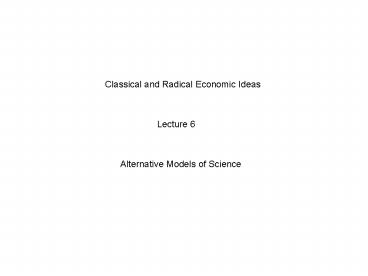Classical and Radical Economic Ideas - PowerPoint PPT Presentation
1 / 8
Title:
Classical and Radical Economic Ideas
Description:
Combining the two views of science. Rationalism and the fallacy of methodology again ... Can be used to categorise CHANGES in economic thinking ... – PowerPoint PPT presentation
Number of Views:58
Avg rating:3.0/5.0
Title: Classical and Radical Economic Ideas
1
Classical and Radical Economic Ideas
Lecture 6
Alternative Models of Science
2
CREI Lecture 6 Alternative Models of Science.
Outline
Popper and Economics
Normal and Revolutionary Science
Combining the two views of science
Rationalism and the fallacy of methodology again
3
CREI Lecture 6 Alternative Models of Science.
Popper and Economics
Hypothetico-deductive method popular with
economists in 1950s and early 1960s
Introduced a strict rationale for testing theory
with empirical evidence, this remains its legacy
in economics.
But two problems
Quine-Duhem thesis
Too many theories refuted too quickly and
easily.
4
CREI Lecture 6 Alternative Models of Science.
Normal and Revolutionary Science.
In 1960s a new view of science challenges the
Popperian orthodoxy -
that of Thomas Kuhn in his book Structure of
Scientific Revolutions
A distinction is made between
NORMAL SCIENCE
and
REVOLUTIONARY SCIENCE
5
CREI Lecture 6 Alternative Models of Science.
Normal Science
During the periods of normal science, the vision
of nature and its laws as well as the methodology
of the science are basically fixed
This vision is called a PARADIGM
Scientists work WITHIN this paradigm and do not
challenge it empirically or theoretically
The empirical and theoretical task of scientists
is to expand the paradigm by solving problems and
determining the quantitative parameters of the
laws of nature
In neo-classical economics- individualism is
unchallenged and economists seek to refine their
theories of choice and the market. Private
property is accepted as the natural and
unchallengeable social institution for resource
organisation.
In neo-classical economics- the empirical
methodology is econometrics which is used to
establish the parameters of choice and markets
eg quantitative estimates of elasticity
These form the neo-classical paradigm
6
CREI Lecture 6 Alternative Models of Science.
Revolutionary Science
In certain key historical periods existing
paradigms become unacceptable to the scientific
community
NEW ideas and a new vision replace the old
paradigm
There is a PARADIGM SHIFT or SCIENTIFIC REVOLUTION
This happens suddenly and, although led by a few
individuals (eg Gallileo or Einstein) the new
paradigm is rapidly adopted by the scientific
community
Such a revolution occurs for a number of reasons,
many historical and sociological as much as
scientific
Empirical evidence is often not the main reason
for the change. Old ideas are rejected and new
ones accepted a priori (before experience)
In economics we can think about the shift between
- classical and radical economics as such a
qualitative break
or neo-classical and Keynesian macro-economics as
such a paradigm shift
7
CREI Lecture 6 Alternative Models of Science.
Paradigm model good points
Appears to give a much more accurate account of
history of science than the Popperian account
Explains both conservative and revolutionary
epochs in scientific activity
Can be used to categorise CHANGES in economic
thinking ie between NEO-CLASICAL and KEYNESIAN
MACRO-ECONOMICS (and back again?)
Can be adapted to explain why different modes of
thought exist simultaneously in economics ie
radical and classical economics
Can explain the persistence of ways of thinking
in economics
8
CREI Lecture 6 Alternative Models of Science.
Paradigm model bad points
X
Has little EPISTEMOLOGICAL content
X
Cant tell scientists how to proceed ie there is
no explicit OR implicit methodology
X
Cant distinguish good science from bad science
X
Cant distinguish scientific truth from falsity































